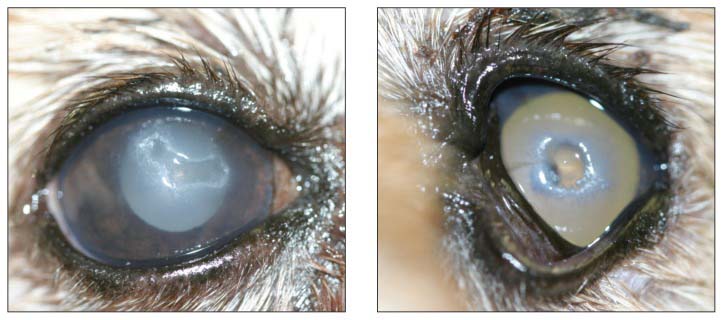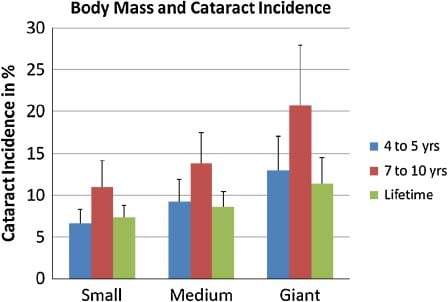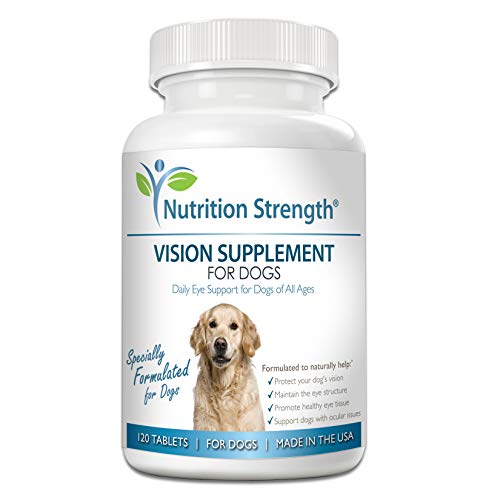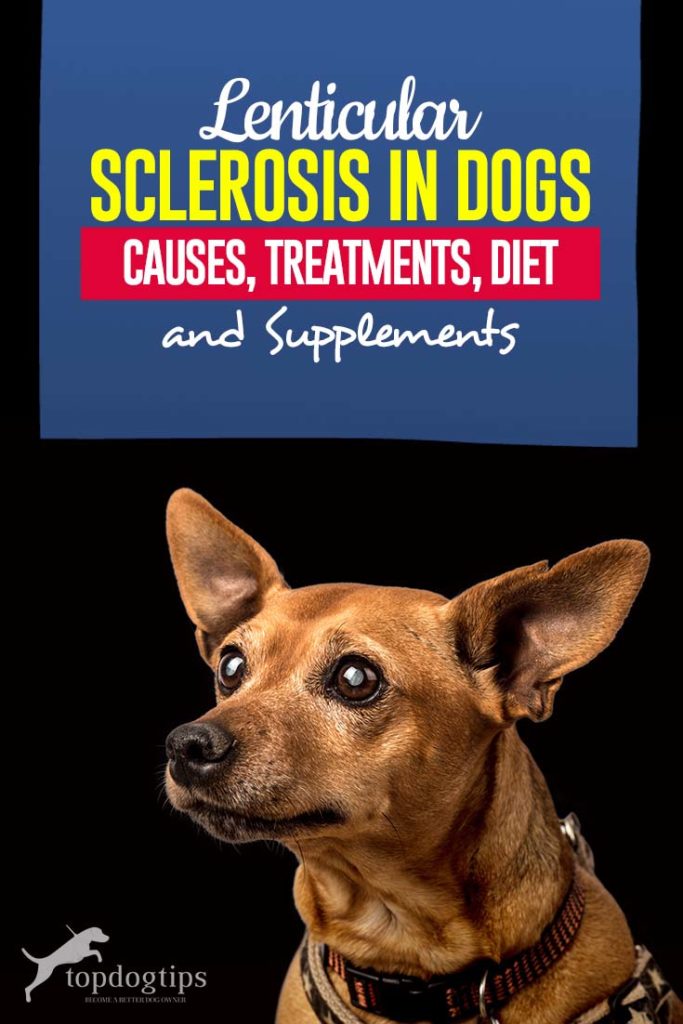Table of Contents
Have you noticed a strange discoloration in one or both of your dog’s eyes and wondered what that is? There could be several reasons for that, but most likely, it's nuclear sclerosis, also known as lenticular sclerosis in dogs.
In this article, we will cover:
- What is lenticular sclerosis?
- What causes lenticular sclerosis in dogs?
- Will a dog get cataracts from this?
- How is a dog's lenticular sclerosis treated?
- Recommended diet and supplements
What Is Lenticular Sclerosis?
A common alternative term used to describe lenticular sclerosis is nuclear sclerosis. It refers to a discoloration in a dog’s one or both eyes that looks like a transparent bluish haze, and this condition is often mistaken for cataracts by pet owners.
This haze develops in the lens of a dog's eye and is more common in middle-aged and senior dogs (1). It can be more easily seen when observing your dog’s eyes from the side rather than head-on.

This cloudy change in the pupil of the eye is considered a normal symptom of old age in senior dogs. It is the second most commonly diagnosed condition in geriatric dogs (2).
In fact, the likelihood of a dog developing lenticular sclerosis has been estimated as high as 50% for dogs over 9 years of age, and even up to 100% for dogs over 13 years of age (3).
In terms of the likelihood of nuclear sclerosis in dogs, it's very similar to cataracts, where breed size and a dog's body mass play an important role. Studies found that large and giant breeds are more likely to develop a variety of eye problems.

Prognosis for Dogs with Lenticular Sclerosis
While there are similarities between the two, lenticular sclerosis should not be confused with cataracts, which is an entirely different eye condition. Unlike cataracts, the outlook for dogs with lenticular sclerosis is usually good, with no significant negative effects on a dog’s vision (4).
Although the vision of the dog does change with lenticular sclerosis, the change to the vision is so gradual that the dog naturally adapts to it. There is no significant sight loss that could affect the dog’s quality of life.
The only real changes are that the dog is likely to see things in less detail, and they may find it more difficult to see well in dim light. But this won't have a big negative impact on your dog because they experience so much of their world through their noses anyway, so they don’t have much of a need to see everything in very sharp detail as humans do.
When your veterinarian examines your pet to check for lenticular sclerosis, they will first dilate the dog's pupil to make viewing easier. They will then use an ophthalmoscope or a similar tool to examine the different parts of the eye (5). Electroretinography is another common method for investigating the health of a dog's eyes (6).
This is such a common condition that your vet will quickly be able to offer a diagnosis and will definitely be able to distinguish lenticular sclerosis from cataracts.
What Causes Lenticular Sclerosis in Dogs?
It isn’t entirely understood as to what causes lenticular sclerosis in dogs, although it seems that as the animal gets older, the lens of their eyes becomes harder (7).
Veterinary ophthalmologists believe that this is because, throughout the dog’s life, lens fibers continue to be produced, but the lens does not become bigger as a result of it. Therefore, the central lens may become compressed by these new fibers, which hardens them and makes the lens appear opaque.
Will My Dog Get Cataracts?
As mentioned above, cataracts is a completely different (and worse) condition, but on the outside, it does look similar to lenticular sclerosis. For this reason, dog owners are often worried that lenticular sclerosis could lead to their dog getting cataracts.
Cataracts look similar to lenticular sclerosis because they are white and opaque. The key difference, however, is that cataracts represent a change in the ability of light to penetrate the retina, and this significantly impairs vision.
The cause for concern is understandable, as many dogs that develop cataracts have previously had lenticular sclerosis, but this is coincidental; the relationship between the two conditions does not seem causal.
Cataracts in senior dogs form after the aging lens fibers degenerate. So it is important to note that not all dogs that have lenticular sclerosis go on to develop cataracts, nor does having lenticular sclerosis mean the dog should get cataracts. Both of these conditions individually do have a high rate of occurrence in older dogs, though.
How Is Lenticular Sclerosis Treated?
Treatment is not necessary for lenticular sclerosis in dogs, aside from your pet's eyes being regularly monitored for the development of cataracts (8). There is no specific treatment to correct lenticular sclerosis, but dietary adjustments can help.
If your dog has lenticular sclerosis, you can also do a few things to make their life easier.
For example, home life can be kept predictable with a consistent environment and routine so that your dog adapts easily to any of the changes in their sight that come with the condition. This can prevent accidents in your home or your dog from becoming spooked by sudden changes that haven’t been anticipated that he may have difficulty understanding.
Nightlights can be used in the evening to help your pooch navigate easily when the light dims. Sometimes, depth perception can be an issue for them, but this is easily assisted with the help of a boost into a car onto a sofa or providing your dog with a ramp.
One big thing that you can do to help your dog with lenticular sclerosis is to provide them with a high-quality diet, and have regular vet checkups and fecal tests to keep your dog worm-free. This is important because many of the intestinal worm larval stages can migrate through the dog's eyes.
If you are looking to delay the changes in your dog’s eye discoloration or prevent other eye-related problems as your dog ages, a good diet supplemented with complementary therapies, antioxidants, and (herbal) supplements may have a positive impact.
Diet for Dogs with Lenticular Sclerosis
Scientists found that adjusting a dog's diet can either slightly prevent the development of lenticular sclerosis or help with symptoms if a dog already has the condition, as well as with other eye-related problems.
For example, one study showed that long-chain (omega-3) polyunsaturated fatty acids delivered in the form of fish oil improved eye condition in puppies (9). In the study, a higher-than-normal amount of concentrated fish oil supplements were administered to achieve the results.
Other studies with both animals and humans found that carotenoids, zeaxanthin, dietary lutein, β-carotene, and a combination of antioxidants such as vitamins C and E are very effective at protecting the retina and lens from oxidative damage, thus preventing a variety of eye conditions that develop with age (10, 11). They absorb the light, which ultimately leads to less light damage (12, 13, 14).
Similar results were observed in studies with dogs where antioxidant supplements helped strengthen canine retinal function and prevent damage (15, 16).
Another study focused specifically on feeding dogs with eye problems, including nuclear sclerosis (17). They found that nutritional factors play a very important role in the health of dogs' eyes, as measured by both ERG and auto-refractor. A control group of dogs fed a special “eye health diet” had visual and retinal improvements whereas a group fed a “regular diet” did not have any improvements over a 6-month period.
Proven recommended supplements for dogs with lenticular sclerosis:
| Preview | Product | Rating | |
|---|---|---|---|

|
Ocu-GLO Vision Supplement for Medium to Large Dogs... | 2,661 Reviews | Check Price |

|
Zesty Paws Eye Supplement for Dogs - Vision... | 2,063 Reviews | Check Price |

|
Nutrition Strength Eye Care for Dogs Daily Vision... | 376 Reviews | Check Price |

|
Ocu-GLO Vision Supplement for Medium to Large Dogs... | 2,661 Reviews | Check Price |
Summary
While it may be worrying when your pet starts to show signs of age, the good thing is that lenticular sclerosis in dogs is mostly a “cosmetic” condition that only slightly affects your dog’s actual sight.
If your pooch has developed this condition, the best thing you can do for them is to keep an eye on them to make sure that nothing more serious develops, and then just be aware of the changes so that you can make life more comfortable and the home environment easier to navigate, as your dog keeps getting older.
READ NEXT: Eye Infections in Dogs – Prevention and Treatment (Based on Studies)
Disclosure: We may earn affiliate commissions at no cost to you from the links on this page. This did not affect our assessment of products. Read more here and find full disclosure here.














